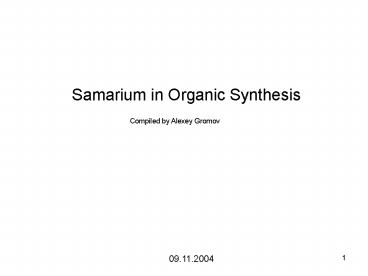Samarium in Organic Synthesis - PowerPoint PPT Presentation
1 / 52
Title:
Samarium in Organic Synthesis
Description:
for differentiation of ketone and ester. for differentiation of halogens (I, Ts Cl) ... coupling with a,b-unsaturated ketones and aldehydes is possible with ... – PowerPoint PPT presentation
Number of Views:197
Avg rating:3.0/5.0
Title: Samarium in Organic Synthesis
1
Samarium in Organic Synthesis
Compiled by Alexey Gromov
09.11.2004
2
the most favorite method
3
General notes
HMPA and DMPU substantially increse activity of
SmI2 HMPA normally 2-5eq. DMPU to get the same
result 30eq -gt complex is not soluble in THF, but
soluble in CH3CN HMPA accelerates reduction of
CO, but more then 4 eq makes no difference HMPA
accelerates reduction of alkyliodies and the more
HMPA the better -gt if during the addition to the
carbonyl you have reduction of CO as a side
reaction then may be to add more HMPA? (not
written but looks like?)
TL (1998) 4429 JOC (1993) 5008 TL (2000) 8049
JACS (2002) 6895
(see examples later)
4
Coupling of organic halides with carbonyl
compounds promoted by SmI2
dilution helps to get cyclized products (without
substituents up to 80 of the cyclized
product) TL (1993) 1717
8 92
2.3 eq HMPA
5 eq HMPA
56 44
5
Side reactions
possible to make preparative
possible to make preparative
6
Organic halides
JOC (1998) 4366
7
Carbonyl compounds
sidereactions
8
- Samarium Grignard Reaction (SGR)
- substrate react faster with SmI2
- Samarium Barbier Reaction (SBR)
- organic halides (allyl or benzyl) prone to
dimerize - organic halides prone to decompose via
a-elimination - capable to react with themselves (bearing CO2R)
9
Alkylhalides
Smo
Chem Lett (1994) 379
Sm(OTf)2 gives
better stereochemistry
JOC (1996) 5400
(from Sm(OTf)3 and s-BuLi)
10
- Intermolecular reactions
- for differentiation of ketone and ester.
- for differentiation of halogens (I, Ts gtgt Cl)
- perfect when there is ester- or cyanogroups in
alkylrest.
ChemLett (1987)1487
ChemLett (1987)1487
JACS (1980) 2693
11
Intramolecular cyclizations
Tet (1997) 9023
JOC (1986) 1778
12
Tet (1997) 9023
JACS (1987) 453
13
TL (1996) 2805
only for 3-carbon chains. 4-carbon
stereoslective intamolec. Meerwein-Pondorf Verley
ox. 5-carbons didnt try
JOC (1994) 3445
yields ca 60 if there is a-OBn
Tet (1994)13575
14
Michael addition
JOC (1997) 7418
59
15
TL (1988) 4847
TL (1984) 3225 Cem Lett(1993) 653
Kasuka, Y Matsubara, Sutimoto, K. Proceeding of
the OMCOS 8 meeting, Santa Barbara, 1995, poster
175 Chem Rev (1999) 745
16
Allylhalides
TL (1982) 3497
Chem Rev (1999) 745
17
Intermlecular
TL (1997) 6585
Chem Lett (1987) 2275
18
Intramlecular
JACS (1987) 453
19
Synth (1997) 219
20
JOC (1994) 702
TL (1986) 1195
21
Aryl- and vinylhalides
Tet (1995) 8555
TL (1987) 5877
JOC (1992) 793 Tet (1995) 3665
22
Reformatsky reaction
Intermolecular
Chem Lett (1995) 197 Bull Soc Chim Fr (1997) 134,
365 J. Synth Chem. Jpn. Special issue in English
(1998) 56 908
23
Intramolecular
possible to make 4-14-membered rings
24
high de also for acyclic ketones
25
Chem Eur J (1999) 121
26
Carbonyl group and SmI2
chelation substantially increases rate of rxns
OL (2000) 2307
similar results for SnCl4 complexation JOC
(1986) 5478
27
(gives SmBr2?)
28
Ketyl -olefin cyclizations
solvent THF HMPA or without HMPA protone
source none or MeOH, t-BuOH, CF3CH2OH
source of protone are also activators for SmI2
29
Intermlecular addition
JCS PT1 (1988)1669 TL (1986) 5763 Alloys Compd
(1993) 192, 197
HMPA accelerates rxn, but deminishes de presence
of H is crutial
JOC (1994) 6900
JCS PT1 (1988)1669
TL (1991) 4921
30
Intramolecular cyclizations
posiible to make 4, 5, 6 and 8 (no7?) membered
rings
the same transformations with Na t-BuOH but
results are much worse JOC (1979) 2369 good
results with the same sterechemistry for simple
substrates got under hv-irradiation JOC (1986)
4196
effect of the CC configuration
TL (1989) 1063
31
effect of the CC configuration chelation effect
Synlett (1993) 158
32
JACS (1989) 8236
JOC (1996) 5885
33
TL (1996) 5817 JOC (1996) 6488
JOC (1992) 3132
JOC (1995) 872
34
65
JOC (1992) 3132
35
protone source effects stereochemistry and yield
JOC (2003) 3190
36
JOC (1994) 5532
TL (1999) 2811 TL (2000) 7673
JACS (2000) 52
37
(No Transcript)
38
Pinacol coupling
we can use
TL (1993) 2311 J Alloys Compd (1993) 192 191
SmBr2 gives better results than SmI2 and SmCl2
39
(No Transcript)
40
conditions effect
PG effect
EurJOC (2000) 1285
for disc. of sterech. see Chem. Rev. 2004 3371
(exact page 3388)
41
chelation effect
temperature effect
42
pinacol coupling with a,b-unsaturated ketones and
aldehydes is possible with Ti-reagents Compreh.
Org. Synth. Vol. 3, p. 576, 577-579
JOC (2000) 6293
43
Reductive cleavage of a-heterosubstituted
carbonyl compounds
ketones. esters, nitriles
mechanism
another limiting mechanism for Hal like for
alkyl-Hal
limitation
44
with MeOH as a H-source OAcgtgtOMe sometimes
transesterefication as a side rxn TL (1989) 2945
Sm(III) can cause opening and rearr. of
epoxides. Sometimes necessary to add Et3N or
for ketonessometimes possible to make cleavage
of OR in the presence of isolateda ketones,
alk-Hal
TL (1987) 4437
45
these additieves not only source of protone but
also activators for SmI2
some useful studies on H-source for carbonyl
reduction d.e. depends on number of eq. and
protone source JACS (2004) 44 JOC (1999) 2172
46
results are more reproducible only in the
presence of Sm0
68
47
stereoelectronic effect
addition of Et3N (to suppress LA-properties)
gives only CO reduction
48
scale influecnces on sideproducts
JOC (1986) 2596
JOC (1986) 5259
49
JOC (1991) 1827
TL (1992) 313
JOC (2002) 2411
with similar substrate 86 yield
50
(No Transcript)
51
(No Transcript)
52
(No Transcript)































